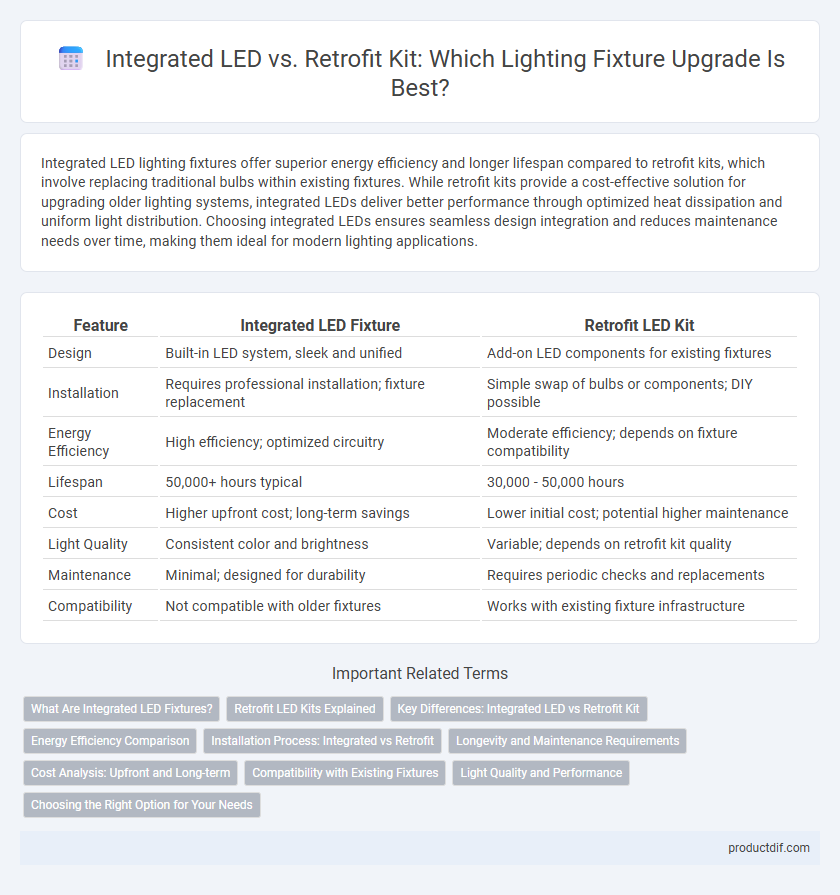Integrated LED lighting fixtures offer superior energy efficiency and longer lifespan compared to retrofit kits, which involve replacing traditional bulbs within existing fixtures. While retrofit kits provide a cost-effective solution for upgrading older lighting systems, integrated LEDs deliver better performance through optimized heat dissipation and uniform light distribution. Choosing integrated LEDs ensures seamless design integration and reduces maintenance needs over time, making them ideal for modern lighting applications.
Table of Comparison
| Feature | Integrated LED Fixture | Retrofit LED Kit |
|---|---|---|
| Design | Built-in LED system, sleek and unified | Add-on LED components for existing fixtures |
| Installation | Requires professional installation; fixture replacement | Simple swap of bulbs or components; DIY possible |
| Energy Efficiency | High efficiency; optimized circuitry | Moderate efficiency; depends on fixture compatibility |
| Lifespan | 50,000+ hours typical | 30,000 - 50,000 hours |
| Cost | Higher upfront cost; long-term savings | Lower initial cost; potential higher maintenance |
| Light Quality | Consistent color and brightness | Variable; depends on retrofit kit quality |
| Maintenance | Minimal; designed for durability | Requires periodic checks and replacements |
| Compatibility | Not compatible with older fixtures | Works with existing fixture infrastructure |
What Are Integrated LED Fixtures?
Integrated LED fixtures are lighting solutions where the LED light source is built directly into the fixture, eliminating the need for separate bulbs or retrofit components. These fixtures offer enhanced energy efficiency, longer lifespan, and streamlined design compared to traditional lighting options. By integrating the LED system, maintenance is reduced and light output is optimized for specific applications.
Retrofit LED Kits Explained
Retrofit LED kits provide a cost-effective solution for upgrading existing lighting fixtures by replacing traditional lamps with energy-efficient LED modules without the need for complete fixture replacement. These kits include LED drivers and compatible hardware designed to seamlessly fit into current housings, ensuring easy installation and improved lumen output. Retrofit kits maximize energy savings and extend fixture lifespan, making them ideal for commercial and residential lighting upgrades.
Key Differences: Integrated LED vs Retrofit Kit
Integrated LED fixtures feature built-in LED light sources designed for optimal performance and energy efficiency, while retrofit kits convert existing traditional lighting to LED without replacing the entire fixture. Integrated LEDs provide longer lifespans and better heat management due to their design, whereas retrofit kits offer a cost-effective solution for upgrading legacy systems quickly. The key difference lies in installation complexity and component integration, with integrated LEDs requiring full fixture replacement and retrofit kits focusing on ease of upgrade.
Energy Efficiency Comparison
Integrated LED lighting fixtures deliver superior energy efficiency by utilizing purpose-built components that optimize light output and reduce power consumption compared to retrofit kits, which adapt existing fixtures with LED modules. Retrofit kits often face limitations in thermal management and optical design, leading to lower efficacy and shorter lifespans. Energy Star ratings highlight integrated LEDs' enhanced efficiency, often achieving 20-30% energy savings over retrofit options in commercial and residential applications.
Installation Process: Integrated vs Retrofit
Integrated LED fixtures feature a streamlined installation process as they come pre-assembled with LED technology, eliminating the need to replace existing bulbs or components. Retrofit kits require more labor-intensive steps, including removing old bulbs, modifying sockets, and ensuring compatibility with existing fixtures. Choosing integrated LEDs reduces installation time and potential errors, providing a hassle-free upgrade compared to retrofit solutions.
Longevity and Maintenance Requirements
Integrated LED lighting fixtures offer superior longevity, often lasting up to 50,000 hours, significantly reducing the frequency of replacements compared to retrofit kits. Retrofit kits rely on existing fixture components, which can limit lifespan and increase maintenance needs due to compatibility issues and potential component wear. Maintenance requirements for integrated LEDs are minimal, as they are designed as a single unit, whereas retrofit kits may demand more frequent inspections and part replacements to maintain optimal performance.
Cost Analysis: Upfront and Long-term
Integrated LED fixtures generally have a higher upfront cost due to advanced technology and design but offer superior energy efficiency and longer lifespan, reducing long-term operational expenses. Retrofit kits typically involve lower initial investment by modifying existing fixtures, yet may result in higher maintenance and replacement costs over time as they rely on older infrastructure. Evaluating total cost of ownership, including installation, energy consumption, and warranty terms, is crucial for determining the most cost-effective lighting solution.
Compatibility with Existing Fixtures
Integrated LED lighting fixtures are specifically designed with built-in LED components, ensuring seamless compatibility and optimal performance within their housing. Retrofit kits adapt existing fixtures to LED technology by replacing traditional lamps or ballasts, but compatibility depends heavily on the fixture's size, socket type, and electrical specifications. Proper assessment of existing fixture dimensions and electrical requirements is crucial to avoid issues like flickering, insufficient light output, or decreased lifespan when choosing between integrated LED and retrofit kit solutions.
Light Quality and Performance
Integrated LED lighting fixtures deliver superior light quality with uniform brightness, reduced glare, and consistent color temperature, enhancing visual comfort and energy efficiency. Retrofit kits, while cost-effective for upgrading existing fixtures, may exhibit variations in light distribution and color consistency due to compatibility limitations. Performance-wise, integrated LEDs typically offer longer lifespans and better thermal management, ensuring sustained brightness and reliability over time.
Choosing the Right Option for Your Needs
Integrated LED fixtures offer superior energy efficiency and longer lifespan by combining the light source and fixture into a single unit designed for optimal performance. Retrofit kits provide a cost-effective solution for upgrading existing fixtures with LED technology while maintaining the original housing and design. Consider factors such as initial investment, installation complexity, fixture compatibility, and long-term maintenance when choosing between integrated LEDs and retrofit kits for your lighting needs.
Integrated LED vs Retrofit Kit Infographic

 productdif.com
productdif.com